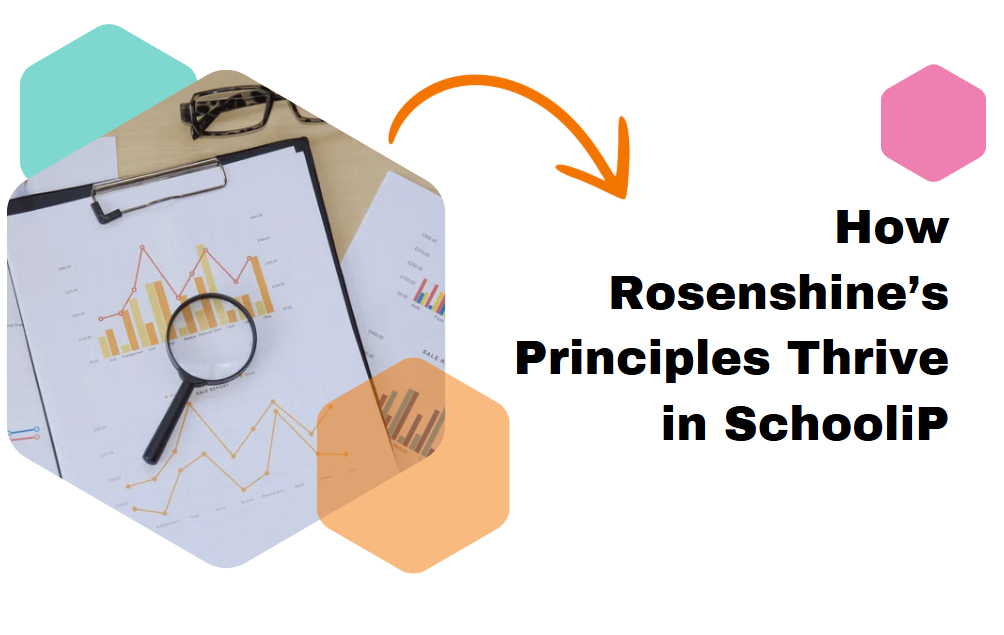How Rosenshine's Principles Thrive in SchooliP


In the dynamic world of education, effective teaching is the bedrock of student success. For years, educators have turned to Barak Rosenshine's Principles of Instruction as a robust, research-backed framework for what works in the classroom. These 10 principles offer clear guidance on how to present new material, engage students, and ensure deep, lasting learning.
However, the challenge often lies in translating these principles from theory into consistent practice, and, crucially, in effectively monitoring their implementation and using that data to guide meaningful professional development. This is precisely where SchooliP emerges as an indispensable tool, offering a seamless platform to embed, monitor, and elevate Rosenshine's Principles across your school.
SchooliP's powerful monitoring module is designed for flexibility, allowing schools to create bespoke observation and learning walk forms that directly reflect their pedagogical priorities – including Rosenshine's Principles.
Here's how it can be tailored:
Customisable Observation Forms:
Break Down Each Principle: For each of Rosenshine's 10 principles (e.g., "Daily Review," "Present New Material in Small Steps," "Ask a Large Number of Questions"), create a dedicated section or specific questions within your SchooliP observation forms.
Rating Scales: Assign clear rating scales (e.g., "Consistently Evident," "Developing," "Not Yet Evident") to each principle or sub-component. This provides objective data on the quality and frequency of implementation.
Comment Boxes for Specificity: Include open-text comment boxes for observers to capture specific, real-world examples. For instance, under "Daily Review," an observer could note: "Students completed a 5-minute quiz on last lesson's vocabulary, linking new terms to prior knowledge." This rich qualitative data brings the ratings to life.
Evidence Capture: Utilise SchooliP's evidence upload feature. An observer could attach a photo of a clear "worked example" displayed in the classroom, or a short video clip demonstrating effective "guided practice."
Targeted Feedback and Data Visualisation:
Real-time Insights: Observations conducted via SchooliP provide immediate feedback. Teachers can view their feedback as soon as it's submitted, fostering timely reflection.
Automated Reporting: SchooliP compiles monitoring data into intuitive reports and graphs. Leaders can instantly see trends across departments, year groups, or even school-wide adherence to specific Rosenshine principles. This allows for quick identification of strengths and areas needing further development.
Identification of Gaps: If reports show that "Scaffolds for Difficult Tasks" are rarely "Consistently Evident," it highlights a clear area for collective or individual professional development focus.
The true power of integrating Rosenshine's Principles into SchooliP extends beyond just monitoring; it lies in using the data to drive meaningful and personalised professional growth through the CPD module.
Connecting Monitoring to CPD Goals:
Personalised Objectives: When an observation identifies an area for growth related to a Rosenshine Principle (e.g., a teacher needs to improve their "Questioning" techniques), SchooliP allows this directly to feed into their individual professional development objectives.
Action Planning: Teachers can create specific action plans within their CPD module to address these objectives. This might involve enrolling in a course on effective questioning, observing a colleague known for strong questioning, or reading relevant research.
Evidence of Impact: Teachers can upload evidence of their CPD activities and, crucially, evidence of how these activities have led to changes in their classroom practice related to the targeted Rosenshine Principle. This closes the loop on learning and impact.
Strategic CPD Planning at Scale:
Identifying Collective Needs: SchooliP's aggregated monitoring reports enable leaders to identify widespread CPD needs related to Rosenshine's Principles. If data shows a school-wide challenge with "Independent Practice," the CPD coordinator can then plan targeted training sessions or allocate resources to address this specific area.
Tracking Progress Over Time: The platform allows leaders to track individual and collective progress against CPD goals and Rosenshine's Principles over academic cycles. This demonstrates the impact of professional development initiatives on teaching quality.
Resource Hub: SchooliP can serve as a centralised repository for resources related to each of Rosenshine's Principles, including articles, video examples, and suggested activities.
By seamlessly integrating Rosenshine's Principles into SchooliP's monitoring and CPD functionalities, schools can achieve several profound benefits:
In essence, SchooliP doesn't just manage processes; it empowers schools to bring the most effective teaching strategies, like Rosenshine's Principles, to life in every classroom, driving continuous improvement and ultimately, better outcomes for every student. It's the bridge between educational theory and transformative practice.